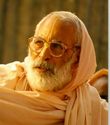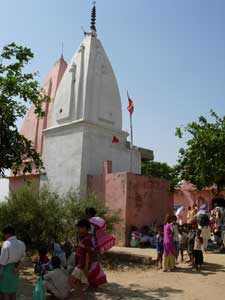
In the morning, the devotees gathered at Gopinatha Bhavan in Vrndavana as usual. Srila Narayana Maharaja spoke on the final verse of Sri Damodarastakam, thus ending his series of lectures on this astakam, by glorifying Sri Radhika.
The 19 large buses started on their journey just after the class, on the way to Sri Giridhari Gaudiya Math at Govardhana, where the parikrama would be based for the next two weeks. On the way the devotees visited Bahulavan, Paitha and Candra-sarovara.
At Bahulavan, the birthplace of a gopi named Bahula, the devotees heard how Sri Caitanya Mahaprabhu came there while He performed His parikrama in Vraja and enjoyed hearing the sweet quarreling talks of the male and female parrot, suka and sari. After Bahulavan, the parikrama party visited Paitha Grama and Candra-sarovara. These places are closely connected with the Rasa-lila of spring-time (Vasanti-Rasa).

The devotees heard there that when Sri Krsna disappeared from the Rasa-arena, He assumed a four-armed form to trick the gopis. All the other gopis simply offered their respects to this form and continued to search for their beloved Krsna. When Sri Radhika approached Krsna, He could not play His tricks on Her, and the two extra arms entered into His body. This place is especially important for the Gaudiya Vaisnavas, because at this place the supreme position of Srimati Radhika was shown.
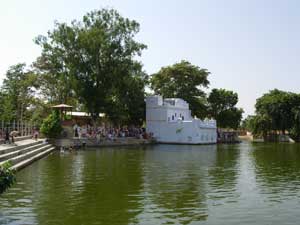
At Candra-sarovara, the devotees heard that Sri Krsna and the gopis danced in their spring-time Rasa-lila. The place is called Candra-sarovara, because the moon (Candra) became stunned upon seeing the dance and stayed still for the whole night, which actually continued for an entire night of Brahmaji.
The devotees arrived at Sri Giridhari Gaudiya Math, happily honored the maha-prasadam of Sri Sri Radha-Vinodabihariji, and settled down in their respective residences at the Matha and the surrounding residences.
In the evening, Srila Narayana Maharaja continued speaking on Madhurya-kadambini. He explained that in the paths of reward-seeking activities (karma) and impersonal knowledge (jnana), the practice is different from the goal that is achieved by the practice. On the path of bhakti, however, the stage of practice (sadhana), the stage of bhava, which is like a sprout of love of Krsna, and the final attainment of prema-bhakti (spiritual love) are all bhakti. They are all bhakti - in its progressively mature stages.
After the class the devotees left to perform the first half of Govardhana parikrama. They visited Sri Dana Ghati, where Sri Krsna became a toll collector and demanded a tax from the gopis. Srila Narayana Maharaja had explained their loving quarrel during his morning class, so the pilgrims continued swiftly on to the appearance place of Sri Nathaji, the worshipable Deity of Srila Madhavendra Puri. The devotees heard there that Sri Nathaji, who is also called Gopala, appeared to Srila Madhavendra Puri in a dream and revealed the place in the bushes where He had been placed many years before. Srila Madhavendra Puri took the Deity ou t of the bushes and began to offer Him gorgeous worship, with the help of the local villagers.
Next, the devotees went to visit the two ponds, Navala-kunda and Apsara-kunda. There they heard that Srimati Radhika and Sri Krsna are present in the form of these ponds. Apsara means a heavenly beautiful young girl, that is Sri Radha, and Navala denotes the youthful Sri Krsna. Nearby is also an arena of Rasa-dance and adjacent to it is a cave where an associate of Sri Caitanya Mahaprabhu, Raghava Pandita, used to perform his bhajana.
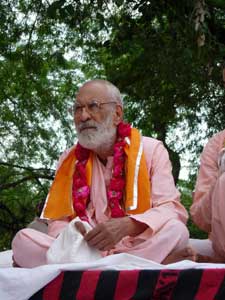
Srila Narayana Maharaja waited for the devotees at Surabhi Kunda.
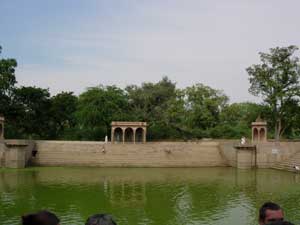
He spoke on the glories of this place, where Indra performed the bathing ceremony of Sri Krsna, with the help of the cow Surabhi.
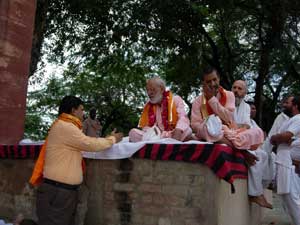
Srila Narayana Maharaja praised the Mathura devotee, Doctor Sanjaya, who has helped in many of Srila Narayana Maharajas projects such as the restoration of this place.
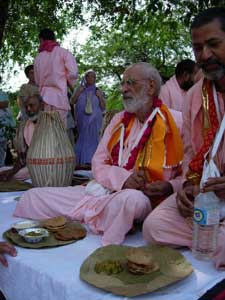
Srila Narayana Maharaja honored prasadam with the devotees sitting around the kunda.
In the evening he spoke on the second part of Madhurya-kadambini, which describes the process and progressive steps of bhakti. He spoke about the initial stage of faith that arises in the sadhaka when he hears hari-katha in sadhu-sanga. He also raised the question of how bhakti, which is transcendental, can manifest on the material senses of the practitioner, and in what way we should see the apparent material body of a personality in whom bhakti has made its appearance.
![[BVML Home Page]](../../grfx/bml_logo.gif)
